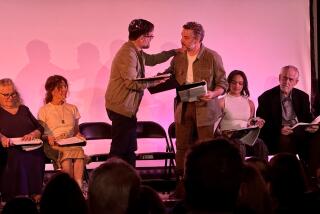O.C. THEATER : Bard Timing: Play’s the Thing : California Shakespeare Update Turns ‘Hamlet’ Into Oddball
- Share via
IRVINE — The oddest modern-dress “Hamlet” I ever saw treated Shakespeare’s greatest tragedy as an analogue of the Kennedy myth. Onstage camera crews shadowed the royal family’s every move for late-night TV reports, turning Denmark into Camelot.
The point of the exercise was not just to exalt the Danish royal family as celebrities in their own time but to remind us that the play’s calamitous events were more than a mere family affair. We were to understand that Hamlet, Gertrude and Claudius were caught up in a public catastrophe with political implications for an entire nation.
The most peculiar moment of the production, however, had nothing to do with that. It came during Hamlet’s famous soliloquy when a not-yet-famous Aidan Quinn, in the title role, went over to a blackboard and wrote with a piece of chalk: “To be or not to be . . . “
If nothing else, such a novel approach to the soliloquy was one way of avoiding the ordinary. Though the rhetorical style may have been rudimentary, it was at least unexpected and certainly not fashionable. But how the Prince of Denmark was supposed to evoke the sonority of Shakespeare’s language with chalk on a blackboard still mystifies me.
Now that I’ve seen the California Shakespeare Festival’s “Hamlet” at the Irvine Barclay Theatre--it ran for one performance Wednesday night--I realize there are many more mysteries to staging a modern-dress version that I may never figure out.
Why, in this production, does Hamlet (Robert Sicular) wear a bandanna wrapped around his head and look like one of Gilbert and Sullivan’s brigands from “The Pirates of Penzance?” And why does he impersonate Groucho Marx? And how does any of that goofiness jibe with the eloquence of his lines: “What is this quintessence of dust . . . man delights not me.”
Oh, I get it. Hamlet is m-a-d, or feigning it.
But why are various royal retainers dressed in black tuxedos to look like waiters some of the time and in garishly colored suits to look like gangsters from “Guys and Dolls” the rest of the time? And why does Claudius (Joe Vincent), in a fit of anger, suddenly brandish a hidden pistol to dismiss the court?
Oh, I get it. This is a post-modern, Brechtian farce. And Claudius is a villain exposed.
But why is Polonius (Bruce Williams), with his clipboard hugged to his chest, played to a star turn as nothing but a dithering fool? Why does one of the gravediggers (Robin Goodrin Nordli) peel a banana and eat it. And why is the Ghost of Hamlet’s father (Richard Elmore) so unimposing? He looks like a toy-sized martinet from the former Eastern bloc and sounds a bit like Brooklyn.
Oh, I get it. Polonius is a vapid clown. The gravediggers are existential clowns. And the Ghost, well, he is not a clown but comes off like one--unintentionally.
Admittedly, “Hamlet” has more variety than Shakespeare’s three other masterworks. “King Lear” may be grander, “Macbeth” more primordial, “Othello” more implacable. None of them covers as much ground, though, or as much chaos.
Still, does that give director Michael Addison license to play everything at the same intensity--punched up to full blast? He not only doesn’t go in for subtlety, he avoids it at all costs.
Sicular’s Hamlet, despite being well-spoken, caroms like a billiard ball. He hits targets broadside. Ophelia (Susan Patterson) crumbles. Gertrude (Hope Alexander-Willis) staggers.
Do they matter? Do we care? Not really. Because, for all its theatrical intensity, the hallmark of this production is cuteness. Addison’s conception invariably goes for laughs. He puts a premium on the jokey.
When Polonius, famed for his thrifty advice (“Neither a borrower nor a lender be”), sees his son Laertes (I. Peter Callender) off to France, he hands him a gold credit card as a going-away gift.
When Hamlet asks to put his head in Ophelia’s lap, his vulgar play on words (“Do you think I meant country matters?”) is italicized for effect, as though in a cartoon bubble.
At the Wednesday performance, this scattershot update turned out to be even less entertaining than it sounds. As scenes ran on from one to the next, strung together like gaudy beads for nearly four hours, the audience steadily melted away into the night.
The most compelling aspect of this “Hamlet,” by the way, was Steve Adams’s incidental chamber music. It alone provided the drama with the semblance of a unifying focus.
* H amlet,” Irvine Barclay Theatre, 4242 Campus Drive, Irvine. Running time: 3 hours, 50 minutes.
Hope Alexander-Willis: Gertrude
Susan Patterson: Ophelia
Joe Vincent: Claudius
Robert Sicular: Hamlet
Bruce Williams: Polonius
Lewis Sims: Horatio
L. Peter Callender: Laertes
Peter Jacobs: Voltemand, a gravedigger
Price Waldman: Cornelius
Hugh Dignon: Rosencrantz, Bernardo
Michael Oosterom: Guildenstern, Marcellus, Fortinbras
Dan Hiatt: Osric
Richard Elmore: A priest, ghost of Hamlet’s father
Robin Goodrin: Nordli Francisco, a gravedigger
Elmore, Nordli: Waldman Players
An Irvine Barclay Theatre presentation of a California Shakespeare Festival production. Written by William Shakespeare. Directed by Michael Addison. Scenic designer: Eric E. Sinkkonen. Costume designer: Barbara Bush. Lighting designer: David K.H. Elliott. Composer: Steve Adams. Fight director: Michael Cawelti. Stage manager: Donna Rose Fletcher.
More to Read
The biggest entertainment stories
Get our big stories about Hollywood, film, television, music, arts, culture and more right in your inbox as soon as they publish.
You may occasionally receive promotional content from the Los Angeles Times.










